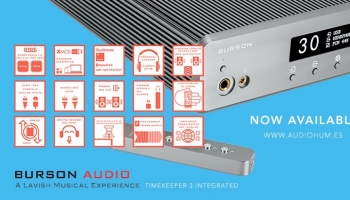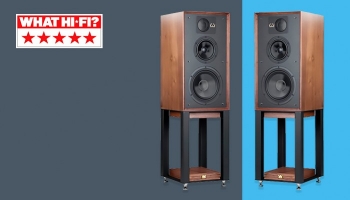LAB 12 Melto1. Review by fairAudio
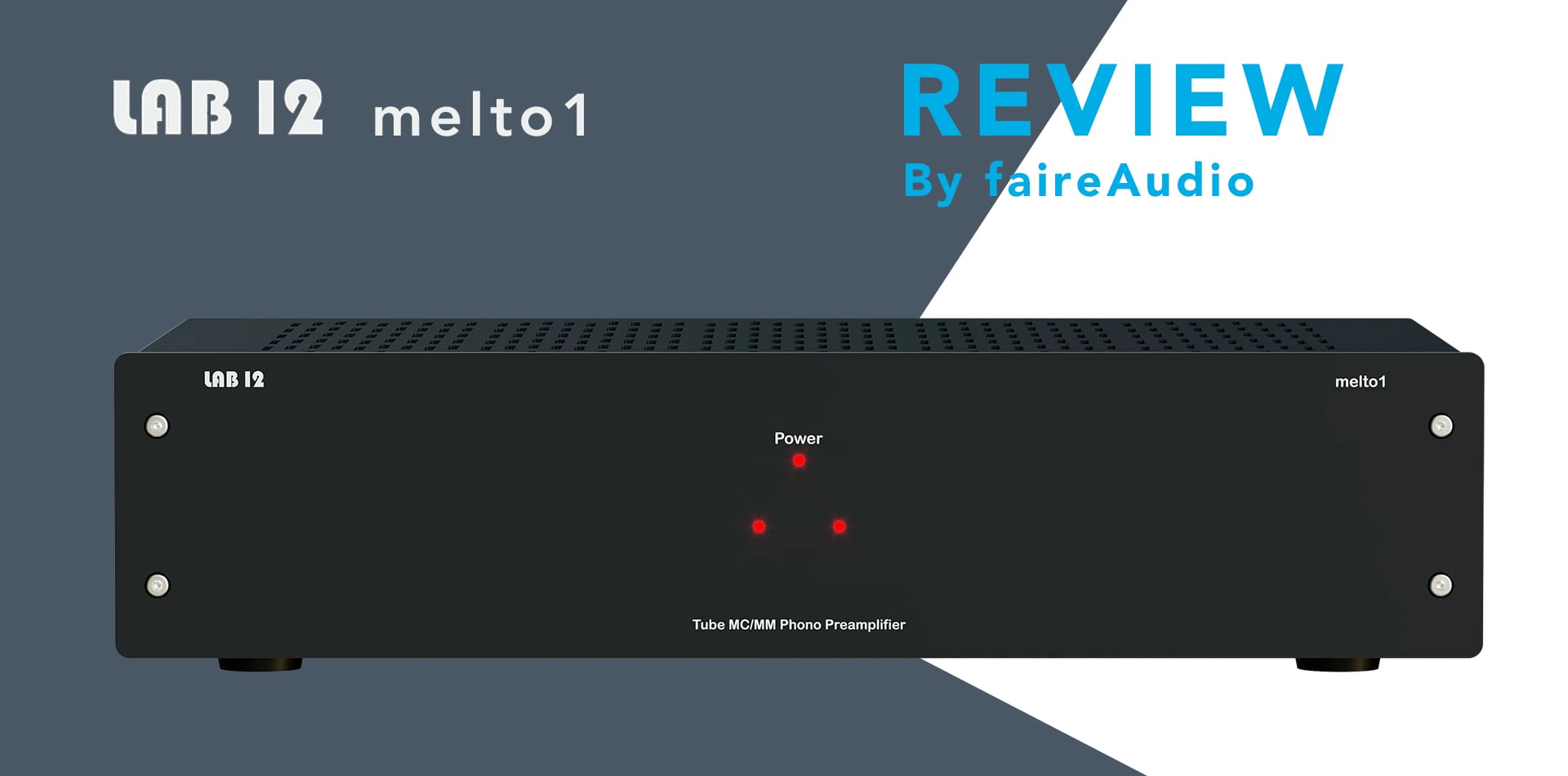
“It's good when you know what you can do without.” Someone who finds out about the two tube phono preamplifiers in the program from the Greek supplier Lab 12 may think something like this. While the Melto2 that we have already tested comes with three separate inputs and the same number of selectable equalization curves, the little brother Lab 12 Melto1 "only" offers the standard RIAA equalization - and a single input on the back. Those are the most noticeable differences between the two. Apart from the fact that our current test candidate is a good 40% cheaper with a purchase price of 2,280 euros.
Lab 12 Melto1 – equipment & concept
Well, it's not quite that simple, there are other differences. The Lab 12 Melto1 phono stage has an unbalanced output, while the top model also has XLR sockets ready - and can be remotely controlled. Of course, that would be a bit too much of a good thing for the Melto1, because there is little to adjust. The eight possible impedance or capacitance values for MC and MM pickups can be selected on the back using DIP switches, and that's about it.
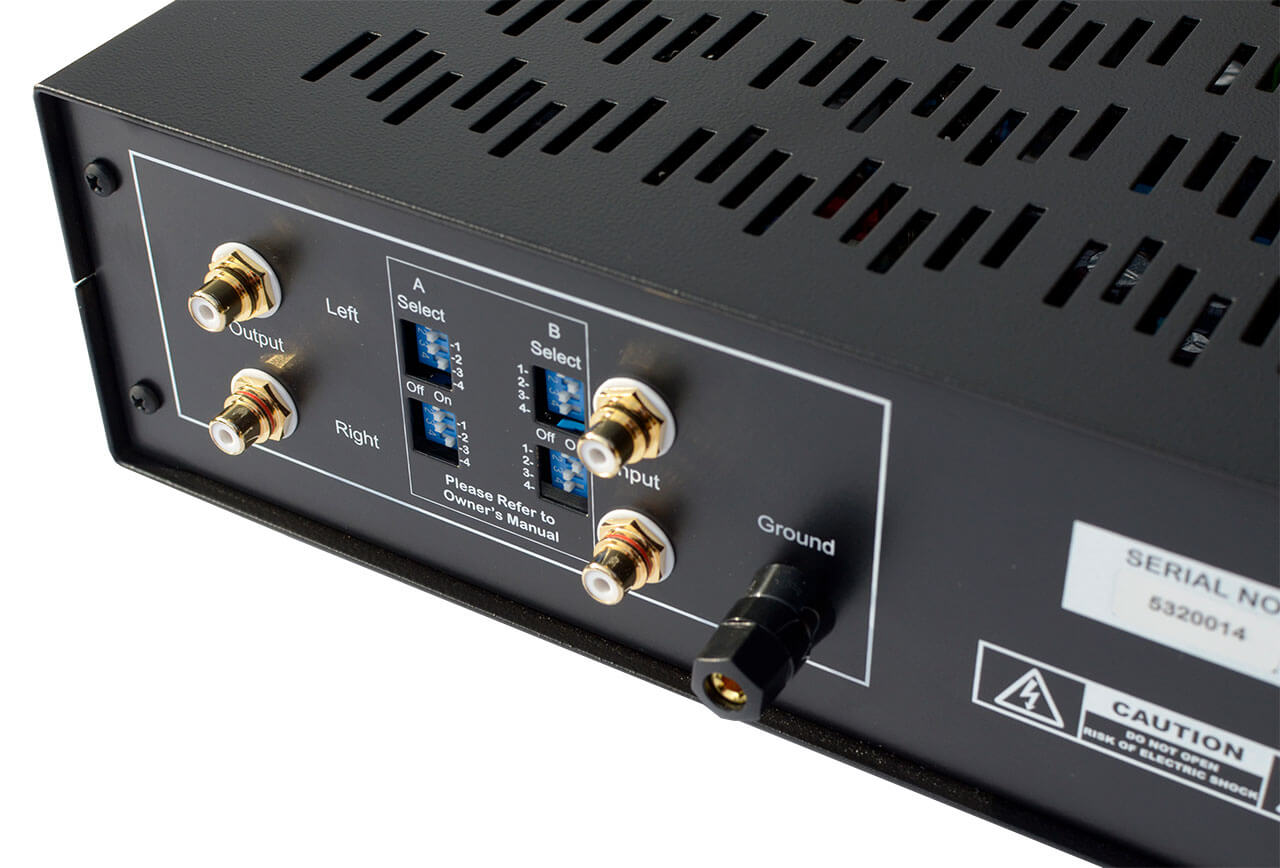
Phono preamp Lab12 Melto1, rear side
Back of the Lab 12 Melto1: One input, one output - and in between the mouse piano, which allows the impedance and capacitance values to be set
This back is correspondingly simple - but the front of the device tops that, on which there are three LEDs that indicate operation, but not a single switch. And this is where I have to turn on the complaining mode: Folks, it's a tube phono preamp, you don't leave it on permanently. An on/off switch belongs on the front, not on the back!
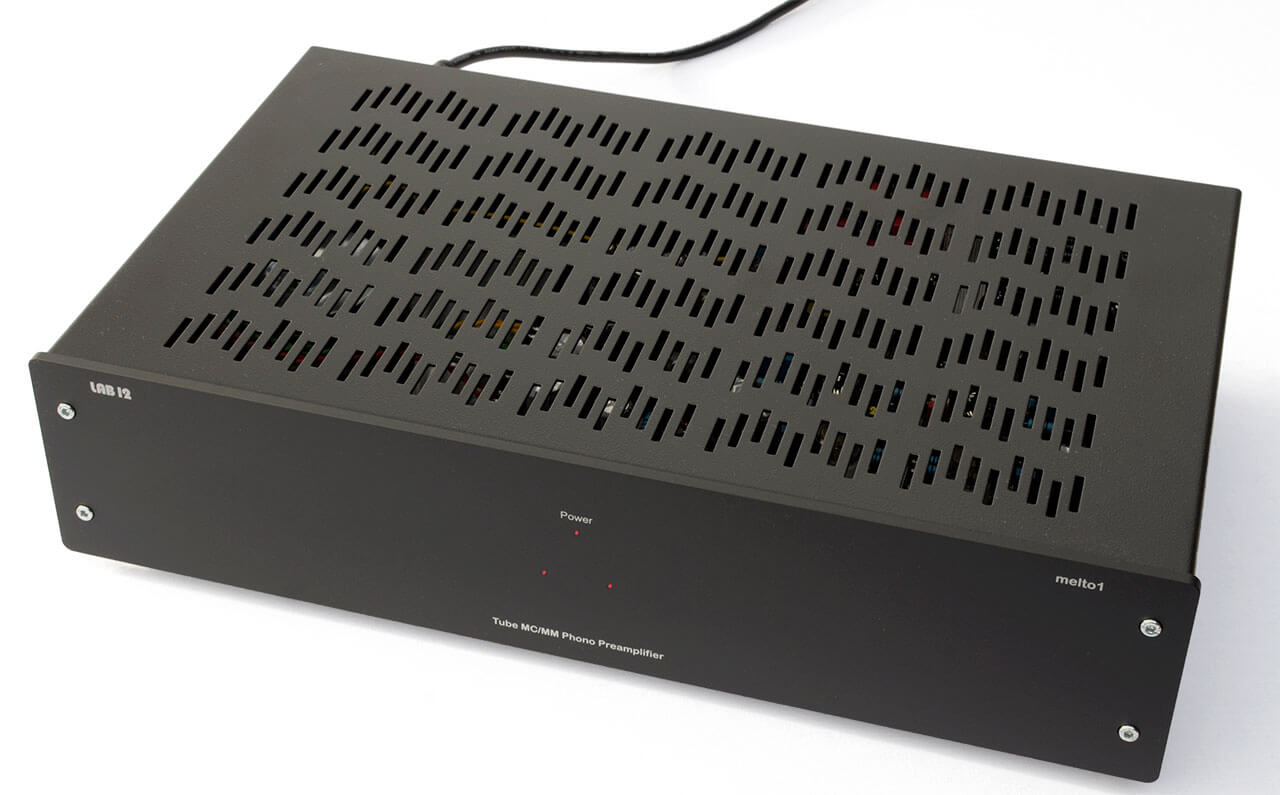
Front of the Lab 12 Melto1 phono preamp
Lab 12 Melto1: There is hardly a simpler way to build a device
A look inside shows a well-dimensioned toroidal transformer on the left and next to it the main circuit board, which carries the power supply on the left and the actual amplifier circuit on the right. The tube phonopre comes with two amplifier stages per channel, resulting in an assembly with four double triodes according to Adam Riese. A 6N1P-EV and 6N2P-EV each provide 41 and 66 dB of gain (MM/MC branch), respectively, between the two triodeslies the passive RIAA equalization, which according to Lab-12 boss Stratos Vichos works very precisely, namely with a maximum deviation of 0.2 dB. Stop, I made a mistake: The two amplifier stages are not true in the case of the MC branch, because the mini voltages of moving coil systems are first boosted by the Melto1 with channel-separated OP amps supplied by a triple stabilized voltage conditioning system, before being handed over to the flask. One could therefore speak of a hybrid circuit, another difference to the Melto2, which uses Lundahl transformers instead of OPs at this point.
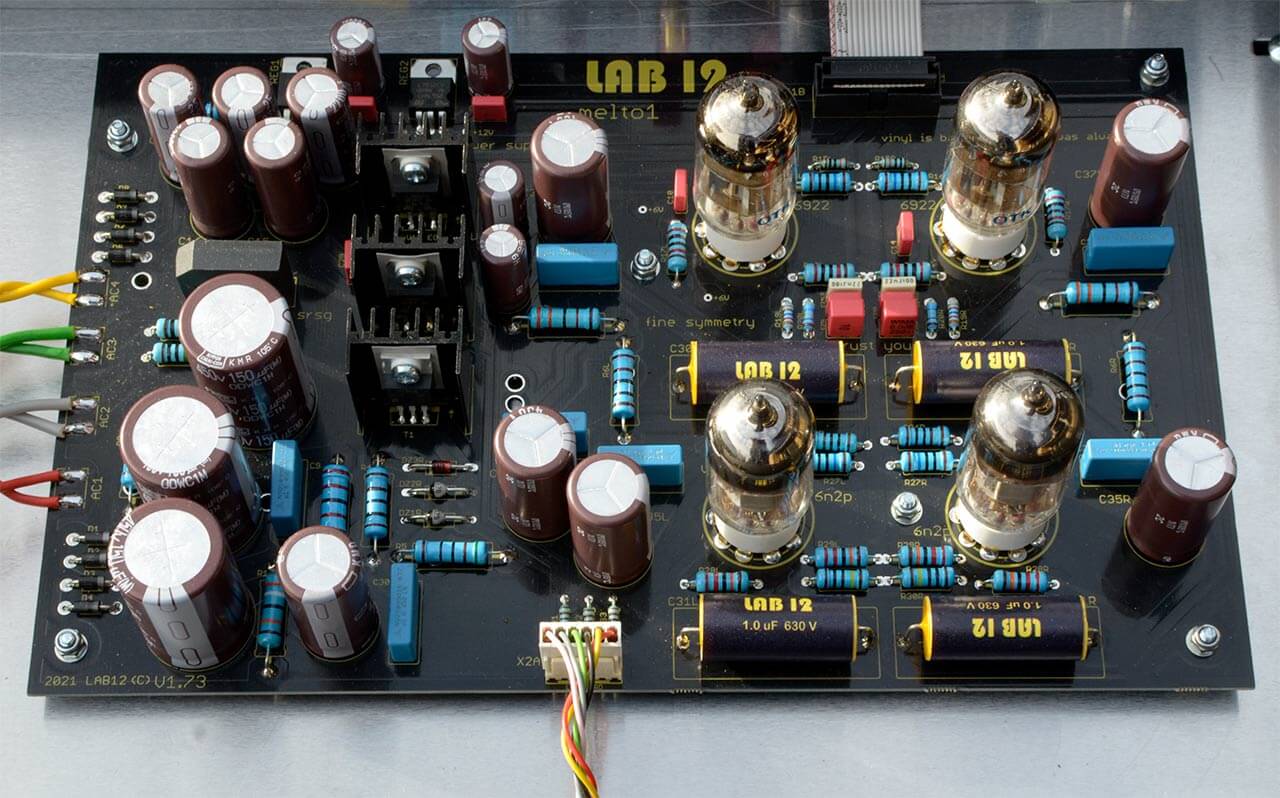
The main circuit board of the Lab 12 Melto1
The main circuit board of the Lab 12 Melto1: the power supply on the left, the amplifier circuit including four double triodes on the right
As further qualities of the Melto1, Vichos cites a particularly low-noise power supply and the so-called fine symmetry circuit board design, which ensures that both channels have "the same paths" (and in particular impedance and capacitance values). In addition, there is a separate ground connection for the signal and power supply, which Lab 12 has dubbed "SRSG topology".
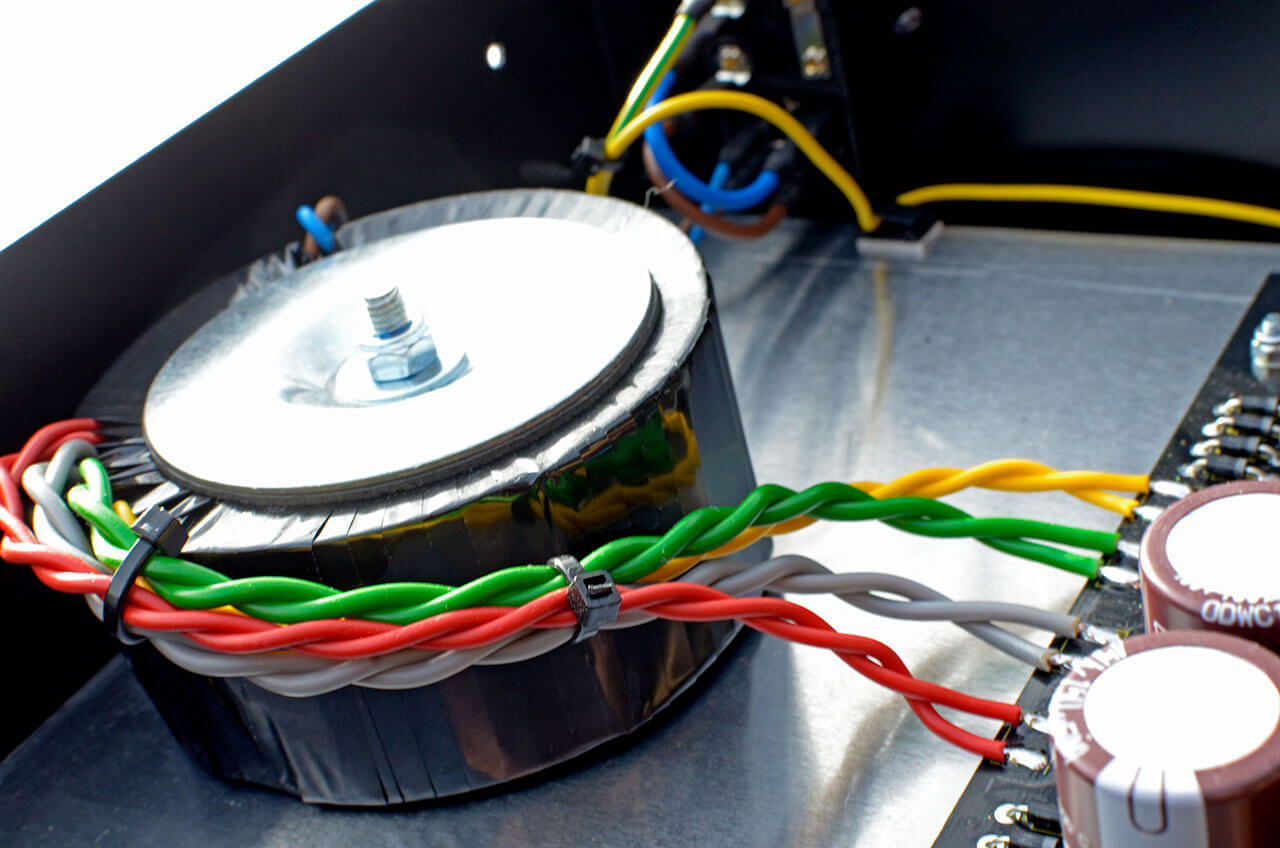
The Phonopre Lab 12 Melto1 weighs 6.5 kilos, the workmanship is good and unpretentious - but the black box is not something to beat the cream on. And speaking of black, that's the only color on offer. And now to the most important thing, the listening impression.
Lab 12 Melto1: Listening Test & Comparisons
In advance of the setup: My Transrotor Figaro was hired out as a low-output MC(2,500 euros) to test the MM branch, the high-output MC Dynavector DV-20X2 H (900 euros) was used, which sends a healthy 2.8 mV to the sockets. With the Transrotor, I started with a terminating impedance of 100 ohms, as recommended by the manufacturer, but I found that too mild in combination with the Melto1 at the top. So try the extreme value of 100 kOhm – it's better. I finally ended up with 390 ohms, the second highest value that the Lab 12 has to offer. That's what seemed the most appropriate to me. The Dynavector played most of the time at 50 kOhm, at 100 kOhm it is a bit fresher, but slightly less vivid in the illustration. Okay, these are all just nuances, but I think it's worth experimenting a bit here.
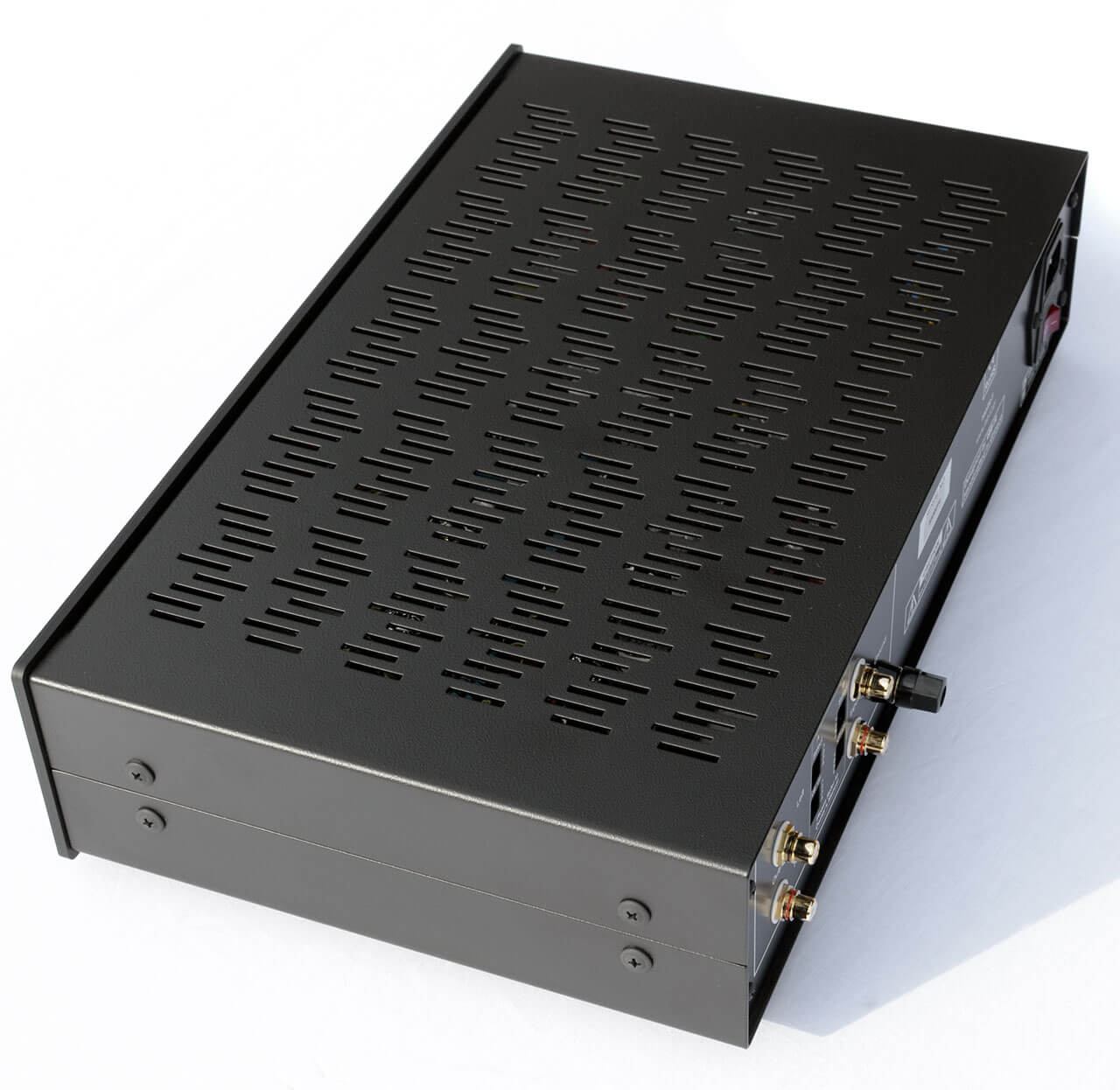
Lab 12 Melto1, top with ventilation slots
The Lab 12 Melto1 phono preamplifier has many ventilation slots on the top, but it doesn't get overly warm despite the tube assembly
macro perspective
To start with, a rough classification. I have the BMC Audio MCCI Signature ULN , and when Musical Fidelity's large Nu-Vista Vinyl phono preamp came out, we ordered it straight away to test. Both are a good 50% more expensive than the Lab 12 Melto1 - and both sound the same: dynamically bright, spatially very accurate and tonally fairly neutral. To put it bluntly, it could be said: They set a counterpoint to the phono cliché. That's not how the Melto1 sounds.
Rather, the Lab 12 gently supports what many vinyl lovers are looking for: beautifully worked out harmonic textures, suppleness, opaque tones. And that's why I immediately thought of another phono stage that basically works in a similar way: the RCM Audio Sensor 2 (2,850 euros). The Polish - although transistorized - is still warmer and fuller on the road, while the tube-equipped Greek comes across as comparatively richer in detail and more subtle. In a nutshell: It positions itself between the aforementioned "pure teaching phono stages" and the swinging, sonorous RCM. Let's take a closer look.
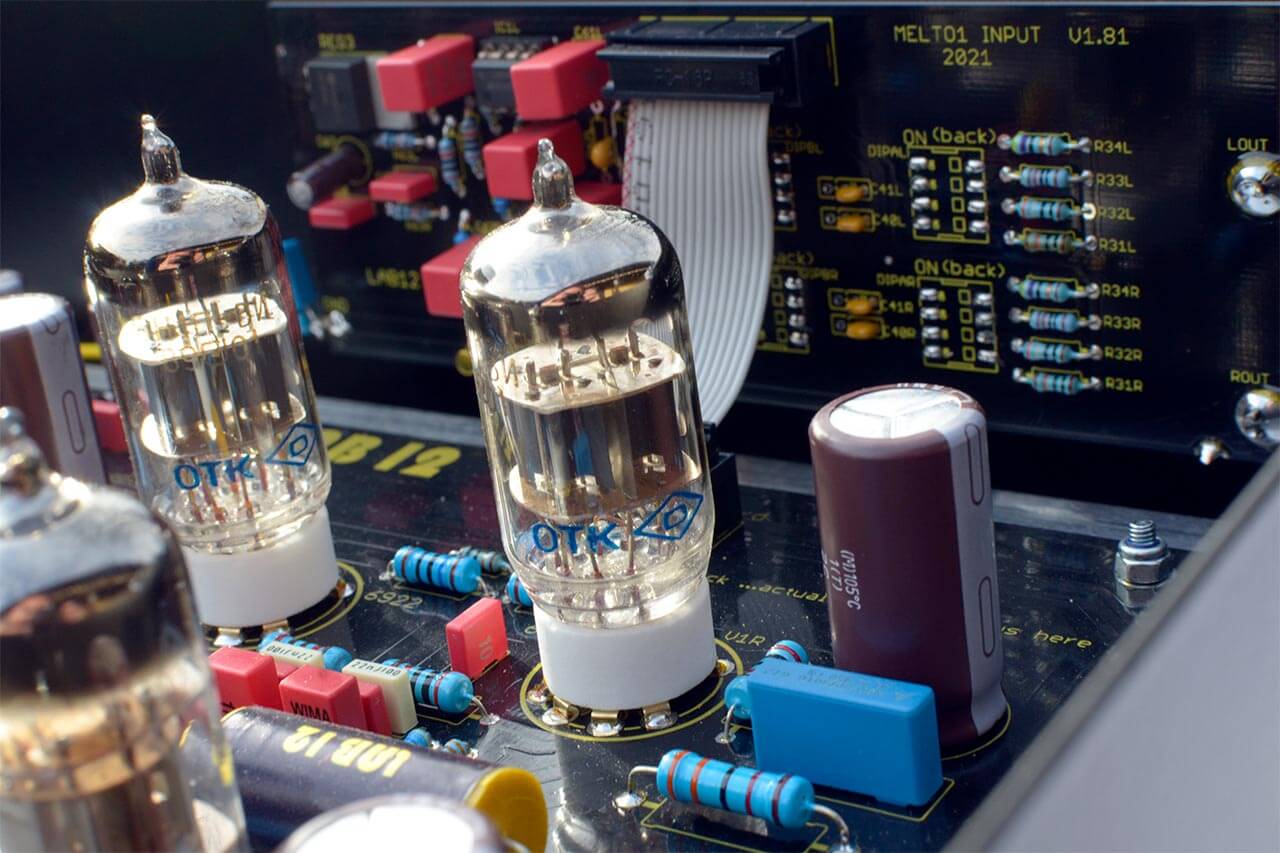
Double triodes in the Lab 12 Melto1
Tonal starting position
All in all, the Lab 12 Melto1 sails fairly balanced through the frequency response, although there are minor deviations from the "perceived studio norm": In the low bass and the treble it is a bit more subtle, in the upper bass/fundamental with a little more energy than in the presence range ( see frequency ranges ). If you now think that this goes quite well with a tube device, I have to agree with you. To be honest, I expected more list. What the Lab 12 "does in terms of sound" is done very discreetly. It is pleasant, sonorous, unintelligently pleasing - and at the same time far removed from classifications à la "scalding warm" or "too cuddly".
The bottom line is that the bass is more tasty than with my BMC. In the absolute bass it has more to offer, but in the musically more important, because more common middle and upper bass, the Lab 12 is a little more vehement, so that it sounds a bit more powerful. In terms of detailing, it doesn't come close to the BMC, but first of all it's more expensive, secondly it has a special talent here and thirdly - probably the most important - the general question is how you prefer to hear it: a little juicier and but softer or super dry and tight-neutral. It is your decision. In any case, what comes across really well and authentically with the Lab 12 Melto1 are deep resonances on the piano or plucked double bass - warm, defined, but not over-controlled.
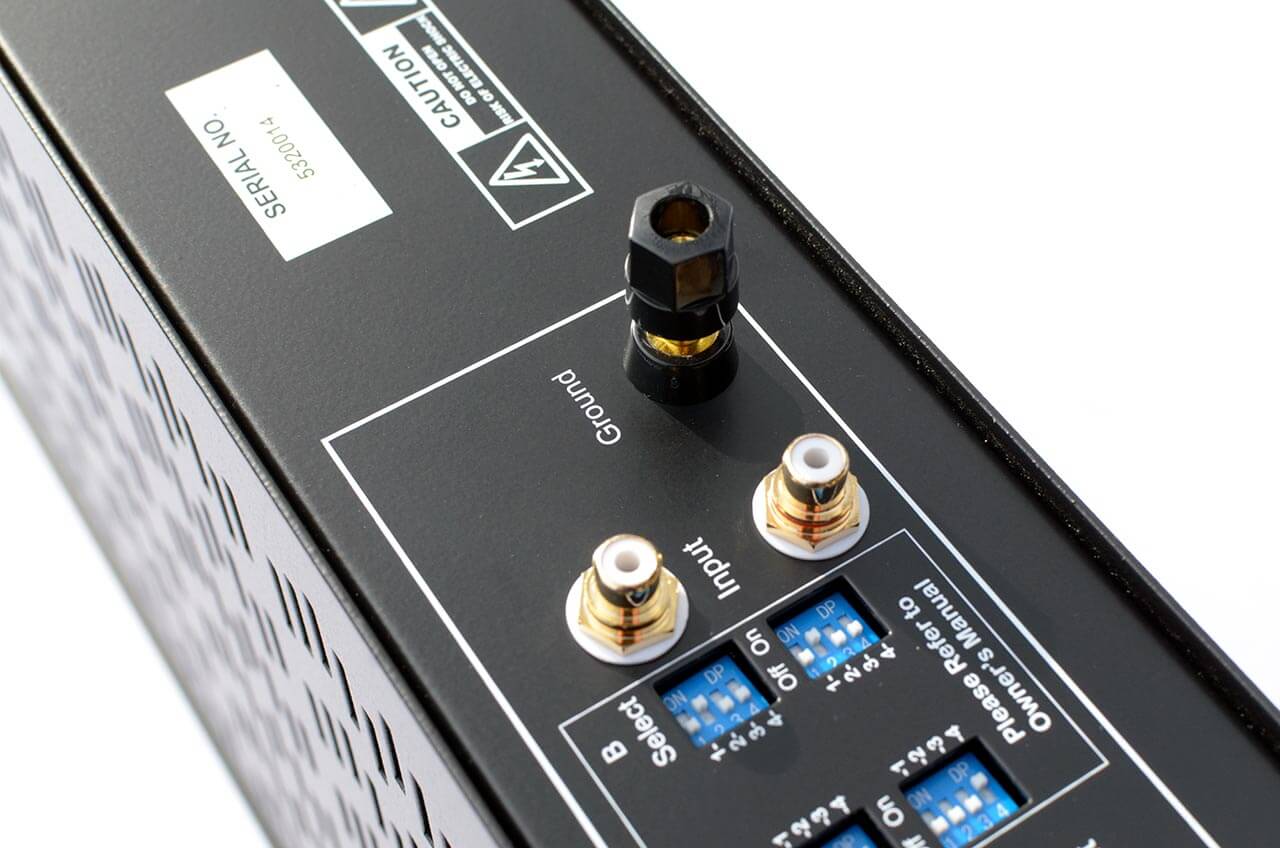
Ground screw on the Lab 12 Melto1
Mids and highs are a smooth unit, nothing sticks out - if you were asked to record the listening impression with pencil and paper, the result would probably be a fairly even line, starting from the fundamental to the super high. The result: A Howe Gelb or Mark Lanegan , who unfortunately recently passed away, sound a little more sonorous than they already are, a Tori Amos or Joanna Newsom not quite as open/free towards the top (which many will appreciate, at least with the latter, I suspect). . Accordingly, the impression is with instruments: NewsomsHarp is presented to me a little more corporeally than usual, while the strings are plucked a little more gently, it seems.
Dynamics, texture, resolution
Ben Harper Welcome to the cruel worldPhysical instead of edgy - that could be the motto of the Lab 12 Melto1. On the Ben Harper track "Like a king" (Album: Welcome to the cruel World; listen on Amazon) I notice a kind of rhythmic accent shift from the drums to the bass. The drum attacks aren't quite as hard as I'm used to, but the e-bass grooves through the booth richer and more rousing. Yes, the Melto1 isn't strictly speaking as dynamic as a Musical Fidelity or BMC, but it does come with that seductive rhythmic flow and boogie factor, quite similar to the aforementioned RCM, albeit with a little more heft to it. Whatever the case, it all sounds casual-swinging-stimulating, the Lab 12 manages to take the listener with it. The famous rocking-along factor, here it is offered in abundance. And that, although I would say that transients have been served harder and more explosively and here more by a smooth, must be spoken in a slightly softened style. Well - obviously groove and smoothness are not mutually exclusive.
Joanna Newsom YsIn line with what has been said so far, the resolving power also has a certain preference, if you will. There are components that know how to work out the attack phase meticulously, so every piano touch is celebrated and zoomed in exactly when the hammer hits the string. The Lab 12 Melto1 is not one of them. No, no, it doesn't do a bad job, but that's just normal, fits the price range, doesn't really stand out as a special feature. Contrasted with the love she gives to the sustain phase... I have to come back to Newsom's harp here, I noticed it on the song "Cosmia" from the album Ys ( listen on Amazon): It just shimmers more now, yes, it looks like a subtle opalescence. It's not just more of a color that is involved here (in the sense of more opaque), it's more about a finer unraveling of nuances of tone color. That's going really well. And since the string section also has a very physical effect, a beautifully rich bouquet is offered. The colors look fresher, more uncovered - not coated, not washed out.
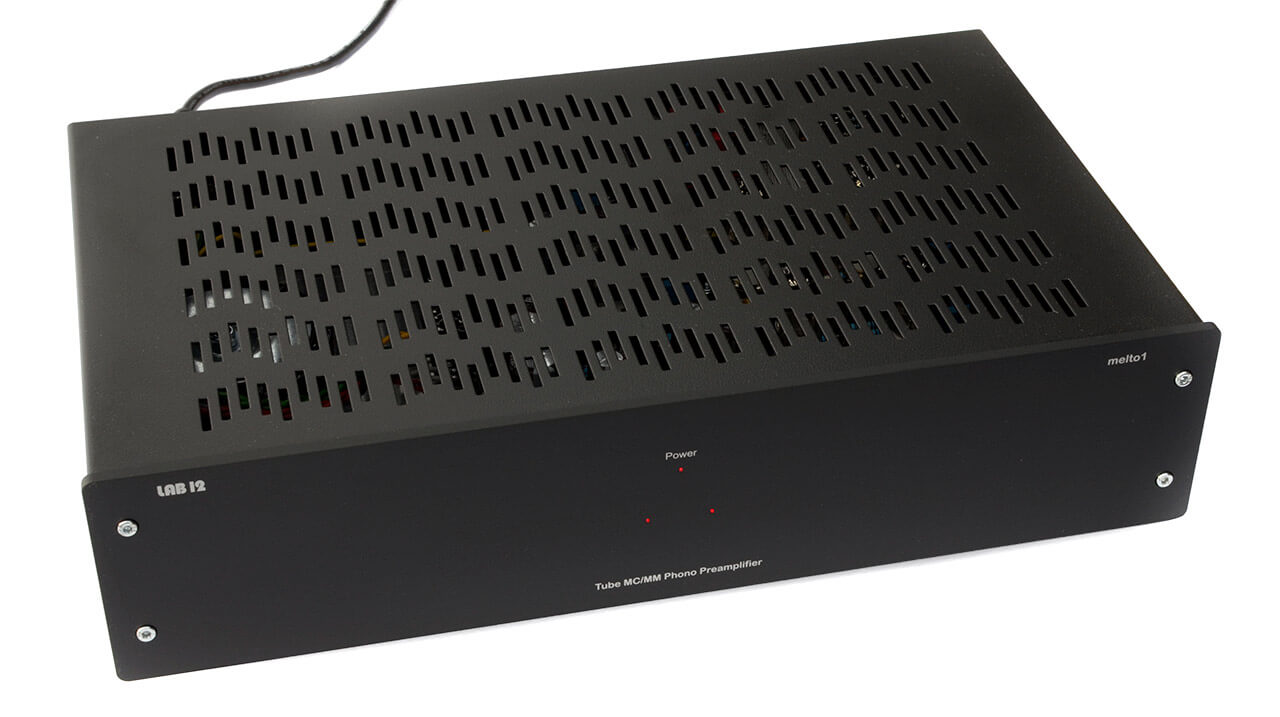
Lab 12 Melto1, front, top left
The stage: loosely layered, organic, round
The virtual stage comes across as realistically lifelike - it doesn't go as far forward as with the aforementioned RCM Audio and not as deep back as with the BMC and Musical phono stages. Rather, the Melto1 starts at or just before the bottom line of the box, offers a decently wide panorama and a loosely layered depth profile. The spatial relationships between the instruments and groups of instruments are clearly comprehensible, but this is not measured like a drawing board, but rather laid out casually.
It goes with the fact that the depiction of the individual voices turns out to be a bit more lavish than is often the case and that the sound bodies are drawn on the edges with a soft pen. Nothing blurs and blurs, no, but it doesn't pass as a 3-D holographic number either.
Family (dis)similarities?
But how does all this compare to its big brother, the Melto2? Unfortunately, I can't tell you first-hand, because I didn't have the top-of-the-line Lab 12 model for a direct comparison. But I can read too, and what my colleague Michael Bruss wrote about the Melto2 , I find part of it in the No. 1 - but not everything.
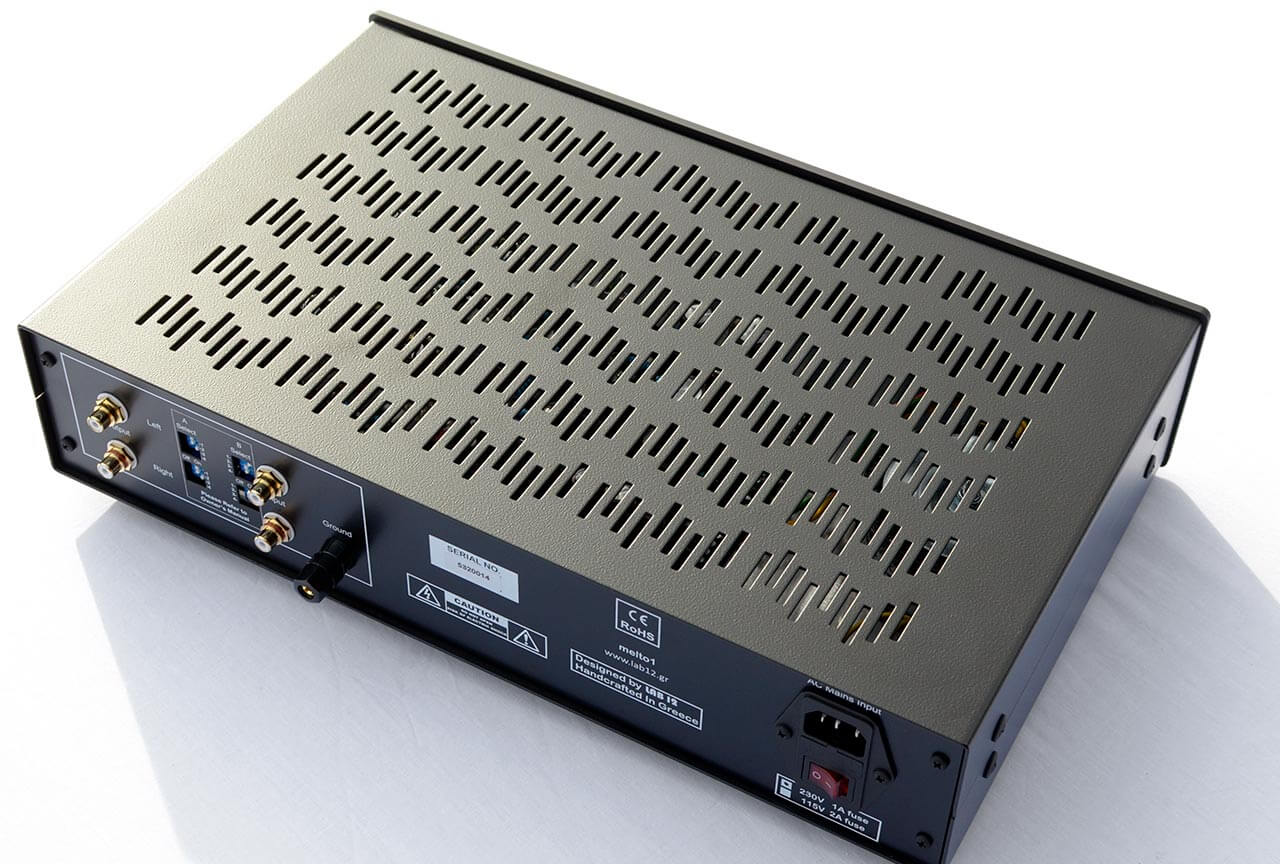
Lab 12 Melto1 - back side from above
A somewhat milder diction in the highest register seems to both have in common, but I can't report that the bass tends to be slimmer with the Melto1, on the contrary. In the wide field between the frequency extremes, the similarities seem to outweigh the "physical solidity" in the fundamental and middle tone that the colleague wrote about, I can at least understand. Alone, the Melto2 still seems to have the edge, especially in terms of resolution and imaging precision. But that's not really surprising given the significant price difference. Most of the time it's not just the greater wealth of features that you have to pay for, but also one or the other sound plus.
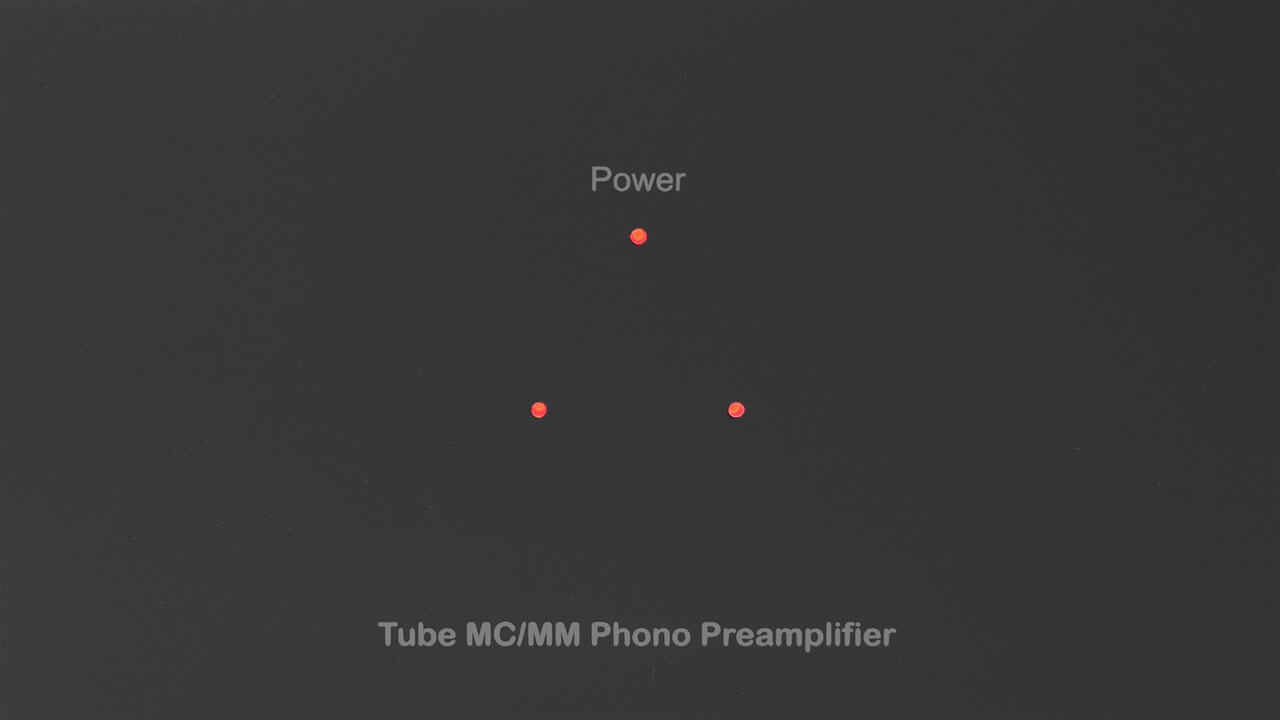
The three red LEDs of the Lab 12 Melto1
All good things come in threes: the Melto1 announces its operational readiness with three red LEDs
The LAB 12 melto1 preamplifier is available at www.audiohum.com/gb
⏩ Shop now here.
Related products
LAB 12 Melto1


